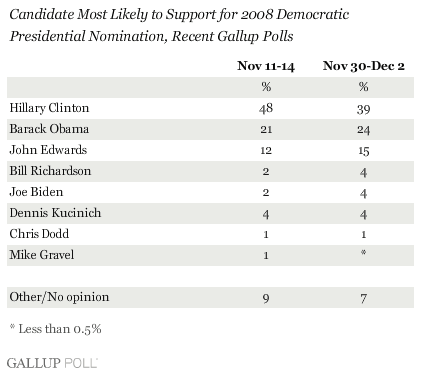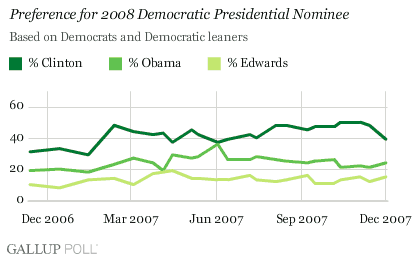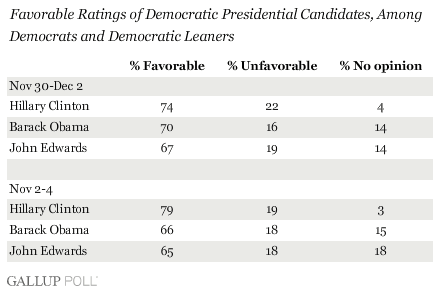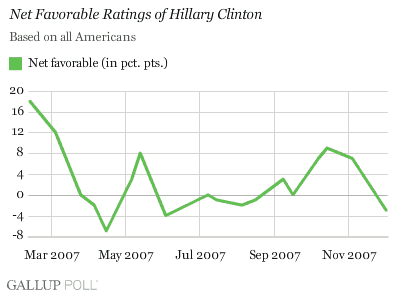PRINCETON, NJ -- A new USA Today/���۴�ýpoll finds Sen. Hillary Clinton continuing to lead the field of Democratic candidates for the party's 2008 presidential nomination, though her support has dropped to its lowest level since June. Thirty-nine percent of Democrats and Democratic-leaning independents support Clinton in the Nov. 30-Dec. 2 poll, with Sen. Barack Obama second at 24% and former Sen. John Edwards third at 15%.
Clinton's support had been 48% in the prior poll, conducted Nov. 11-14, and had been near 50% since mid-September. The drop in her support did not seem to disproportionately benefit any of her rivals; instead, most of the other Democratic candidates appear to have picked up at least some support since the last poll was taken.

Now, Clinton's lead over Obama is about half of what it was when she enjoyed her largest advantage -- 29 points in an Oct. 12-14 poll (50% to 21%). Clinton has led in every ���۴�ýPoll of nationwide Democrats' nomination preferences since November 2006, and has held a statistically significant advantage over all other competitors in all but one of these polls.

One positive sign for Clinton is that her lead over Obama is larger among core Democrats (those who identify with the party rather than those who initially identify as independents but say they lean to the Democratic Party). Among those who identify as Democrats, 47% favor Clinton and 21% Obama. In many states, only those who have officially registered as Democrats can vote in the primaries.
Views of the Candidates
Clinton (74%) has a slightly higher favorable rating than Obama (70%) or Edwards (67%) among Democrats and Democratic leaners. But Clinton also has slightly higher negatives (i.e., unfavorable ratings) among this group than either of her closest pursuers. One in seven Democrats are still not familiar enough with Obama and Edwards to rate them.

Among the general public, opinions of Clinton have been closely divided throughout the year, switching from net-positive to net-negative ratings on several occasions. In the latest poll, the ratings are once again tilting negative, with 47% rating her favorably and 50% unfavorably, after being more positive than negative throughout the fall months.

By comparison, Obama and Edwards have favorable ratings well into positive territory among the general population, with Obama at +20 (53% favorable, 33% unfavorable) and Edwards at +15 (50% favorable, 35% unfavorable). Both candidates have had net-positive scores throughout the campaign.
Implications
Even with a drop in support in the latest poll, Clinton remains the solid front-runner for the Democratic Party's nomination. Her strong positioning in the polls to this point has made her the prime target of the other candidates' attacks, which have become more frequent with the first official votes now just one month away. The stepped-up attacks are likely one reason for the dip in support for Clinton.
While the Iowa caucuses are always important in presidential nomination campaigns, they are widely viewed as the critical race for the Democratic candidates, much more so than for the Republicans. With Clinton enjoying such a consistently large lead in national polls and leading in nearly every state primary pre-election poll, some believe Iowa is Edwards' and Obama's best and possibly only chance to change the dynamics of the race. Polls of likely Iowa caucus voters suggest Clinton is locked in a tight race with Obama and Edwards in that state. A win in Iowa likely would only help bolster Clinton's standing in the races that follow, and make an Obama or Edwards nomination seem less probable.
Survey Methods
These results are based on telephone interviews with a randomly selected national sample of 1,006 adults, aged 18 and older, conducted Nov. 30-Dec. 2, 2007. For results based on this sample, one can say with 95% confidence that the maximum error attributable to sampling and other random effects is ±3 percentage points. In addition to sampling error, question wording and practical difficulties in conducting surveys can introduce error or bias into the findings of public opinion polls.
For results based on the sample of 494 Democrats and Democratic leaners, the maximum margin of sampling error is ±5 percentage points.
